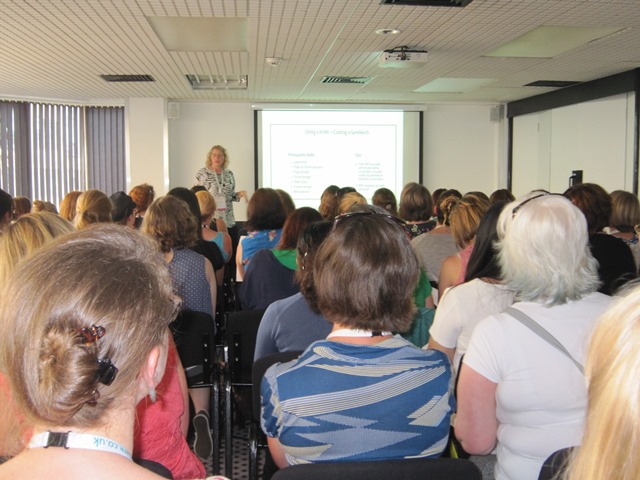By Bhanu Raghavan, MS, OTR/L & Ginger Mc Donald, OTR/L
We were lucky to experience Occupational Therapy on an international level when we were invited to present Self-Care with Flair! at the annual conference of the College of Occupational Therapists (the educational arm of the British Association of Occupational Therapists) in Brighton, England this past summer. We applied to present at the conference over a year before, hoping to spread the word about our book, Self-Care with Flair!, and were thrilled when our proposal was accepted! We immediately began to adapt our presentation to our British audience. Our presentation was well received, and we enjoyed the interaction with our British cohorts. In general, the Brits showed their trademark politeness and hospitality. We had several OTs stop to talk with us when they saw our Therapro name tags to tell us how much they enjoy Therapro’s products.
What we didn’t realize is what an educational experience it was going to be for us! We had a wonderful time roaming the Expo Hall, and learning about the technology and solutions that British OTs have devised for the same problems that we grapple with in the States. Because of the expense involved in shipping over the Atlantic ocean, many of the companies whose booths we visited do not market their products in the USA. Of course there were many products we see in our catalogs in the US, there is so much stuff out there that we don’t know about! We saw an ingenious sling that allows parents and teachers to strap pre-toddlers to their legs, to give them some weight-bearing experience as they learn to. We saw canvas and PVC “quiet rooms” built over beds, much like a tent, meant to give a child having a sensory meltdown a place to safely calm down. Another very brilliant invention was the weighted and huggable beanbag chair. Weighted should pads and lap pads made us “melt away” and say “ahhh..this is life!” We spent time in the BAOT booth just chatting and comparing how our “health care systems” differ.
The educational sessions were fabulous. We attended a general session describing an exciting study co-conducted by British and Dutch OTs that was able to come up with figures for how much money OTs save the health systems in their countries per year. In their socialized medicine systems, the numbers were in the millions! Our system, with private insurance, figures our costs differently, but the potential savings are obvious. The study is not completed, but when the results are fully published, the American health system will notice OT! Ginger attended informative sessions on new evidence about the usefulness of hip precautions (the Brits are slowly dropping them), a company that builds elevators in tiny British homes, and together we attended a fabulous session on night time positioning to prevent the many orthopedic issues with individuals with multiple handicap.
As much as we joked and laughed about our differences, our new OT friends agreed with us that we OTs are very much alike. The emphasis on function and purposeful engagement in meaningful occupations is the foundation of our profession in every country. We were honored to be asked to pose for a photograph featuring the “international therapists”.
Many therapists that attended our presentation emailed us about their thoughts (see below some comments from the participants). Thanks to Self-Care with Flair! we felt the kindred spirit as OTs due to our global emphasis on balance and meaningfulness to life regardless of whether or not one has a disability.
Since we were going to go such a long way for our two hour presentation, we decided to make good use of our time in Europe to visit old friends in England and Scotland, and to tour Budapest, Vienna and Prague. Every country with its own charm kept us hopping!
Bhanu and Ginger
Authors of Self-Care with Flair!
Comments From Participants
“Thank you for visiting England and sharing your Self-Care with Flair – your session at the conference was fabulous.” – Sally Townend, Children’s Occupational Therapy
“Firstly thank you so much for a wonderful presentation on Self Care with Flair at the recent COT conference in Brighton. I could have listened to you all day, it was fascinating and I really enjoyed the session. I love the whole concept of your innovative program, it’s so simple yet effective, I loved your rhymes and only wish I had invented it as you must have had so much fun making them up. Thank you once again for a brilliant talk and may I congratulate you on an inspired and very useful OT tool.” – Janine Hackett, University of Derby
“I must say I am super happy that I had the wonderful pleasure of meeting both of you and learning something new and wonderful too!!! Your presentation was FANTASTIC!!!!” – Vlada Poliakov
“I thoroughly enjoyed your interactive workshop at the COT conference last week and I learnt a lot so thank you!” – Nicole Tee





 Popular speaker and Therapro author of
Popular speaker and Therapro author of  Tere is always an engaging and interesting presenter. She used humor and anecdotes liberally to engage her audience. The more than 50 attendees at the seminar eagerly participated in visualization exercises individually and in pairs. The room was alive with energy and laughter!
Tere is always an engaging and interesting presenter. She used humor and anecdotes liberally to engage her audience. The more than 50 attendees at the seminar eagerly participated in visualization exercises individually and in pairs. The room was alive with energy and laughter!